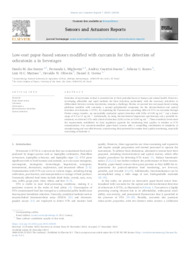Low-cost paper-based sensors modified with curcumin for the detection of ochratoxin a in beverages.
Low-cost paper-based sensors modified with curcumin for the detection of ochratoxin a in beverages.
Author(s): SANTOS, D. M. dos; MIGLIORINI, F. L.; COATRINI-SOARES, A.; SOARES, J.; MATTOSO, L. H. C.; OLIVEIRA, O. N.; CORREA, D. S.
Summary: Ochratoxin A (OTA) is a mycotoxin that can contaminate food and is produced by fungal species such as Aspergillus carbonarius, Penicillium verrucosum, Aspergillus ochraceus, and Aspergillus niger [1]. OTA poses significant risks to both humans and animals, as it can cause mutagenic, carcinogenic, teratogenic, hemorrhagic, hepatotoxic, estrogenic, immunotoxic, dermatoxic, nephrotoxic, and neurotoxic effects [2–5]. Contamination with OTA can occur at various stages, including during cultivation, post-harvest, and transportation or storage of food produce. Commonly affected food items include dried fruits, cereals, nuts, corn, oats, coffee, grape juice, wine, wheat, and beer [6–9]. OTA is stable in most food-processing conditions, making it a persistent concern in the realm of food safety [4]. Consumption of OTA-contaminated food has emerged as a substantial public health issue that requires immediate attention. Currently, analytical methods such as enzyme-linked immunosorbent assay (ELISA) [10] and chromatographic assays [11] are employed to detect OTA and monitor food quality. However, these approaches are time-consuming and expensive and require sample preparation and trained personnel to operate the instruments. To address these limitations, alternative systems have been proposed, including electrochemical and optical sensors, which offer simpler procedures for detecting OTA traces [4]. Surface functionalization [5,12,13] can further enhance the performance of these sensors. Notably, paper-based sensors show great promise as they fulfill the requirements for point-of-attention food monitoring, are low-cost, portable, and versatile [14,15]. Additionally, functionalization can be accomplished using a wide range of raw, biodegradable materials [16–18]. In this study, we present an innovative paper-based sensor functionalized with curcumin for the optical and electrochemical detection of ochratoxin A (OTA), as illustrated in Scheme 1. Curcumin is a highly promising sensing element due to its affordability, widespread availability, non-toxicity, and pronounced fluorescence that is quenched in the presence of OTA [19–25]. Notably, curcumin also possesses redox-active properties, with two distinct redox centers: a ?-diketone.
Publication year: 2024
Types of publication: Journal article
Unit: Embrapa Instrumentation
Observation
Some of Embrapa's publications are published as ePub files. To read them, use or download one of the following free software options to your computer or mobile device. Android: Google Play Books; IOS: iBooks; Windows and Linux: Calibre.
Access other publications
Access the Agricultural Research Database (BDPA) to consult Embrapa's full library collection and records.
Visit Embrapa Bookstore to purchase books and other publications sold by Embrapa.

